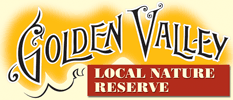

|
This section describes some of the common (and not so common) species that you might find at Wick Golden Valley LNR.
Bats
The tree-lined river, which runs through the reserve and surrounding areas, attracts large numbers of insects and on calm summer evenings Daubenton's bats skim the water surface for emerging midges while Pipistrelles circle the trees above. In the surrounding fields the larger Noctule and Serotine bats have been detected foraging for their favoured prey of more substantial insects like cockchafers and moths. The Horseshoe bats have been recorded flying along the woodland edge which is typical behaviour for the species.
The remains of the industrial workings on site mimic underground caves and the presence of droppings have shown that bats have roosted in them. The bat boxes in the reserve provide further roost sites where several other species have been found, including Brown Long Eareds, Natterers, Whiskered, Leisler's and Bechstein's.
For more information on bats visit the Bat Conservation Trust at http://www.bats.org.uk
Dipper
Cinclus cinclus
These amazing birds are
found on fast flowing upland rivers, and lowland rivers with weirs.
Dippers are the UK’s only truly aquatic bird; they can dive for aquatic
insects, swim on the surface or underwater using their wings and walk
on the river bottom. They hunt underwater by sight – a nictitating
membrane protects their eyes so they can still see. They eat mainly the
nymphs and larvae of mayflies, caddisflies and stoneflies – which are
all very susceptible to pollution, so Dippers mean the River Boyd is
clean.
Sometimes described as dumpy they are compact birds with a short tail. Their plumage is dark with a distinctive big white bib. The head and the area beneath the bib are chestnut brown.
They are called dippers because of the way they curtsey or bob when perched. Usually they are seen because they’ve seen you first – and flown away up or down stream, calling ‘zit zit’.
Early breeders, they have usually laid eggs by the end of February. They build domed nests out of reach on rock or buildings over water or behind waterfalls. They tend to stay near their breeding areas in winter unless the weather is very cold, when they move to estuaries and coastal areas.
White-legged Damselfly
Platycnemis pennipes
White-legged
Damselflies are a special and quite scarce species; in the UK they only
occur in the southern half of England and eastern Wales. They are
usually found in dense vegetation alongside flowing water, or in nearby
lush meadows. They fly between late May and mid-August.
This is basically a blue and black damselfly, but if you look carefully (binoculars help!) they are quite distinctive. Much paler than the other blue damselflies (and more difficult to see), they range from pastel blue to cream (or palest green in the females), with fine black markings running along the length of the abdomen. The give-away (if you can get a good view) is the lower legs – these are flattened with long black hairs, looking like creamy-white feathers. Unusually for damselflies they have a courtship display – the males flutter their legs in flight to attract the females.
White-legged Damselflies are vulnerable to water pollution and also over-zealous vegetation clearance. Vegetation management can happen for flood control or drainage reasons and intensively managed watercourses are unlikely to support White-legged Damselflies.
The presence of White-legged Damselflies indicates that there is suitable habitat for nesting birds, other invertebrates, amphibians, breeding fish, and small mammals – as well as damselflies!
Otter
Lutra lutra
In England and Wales these
must be the ultimate elusive animal. Some people study them for years
and never see them! Luckily they do leave some signs that they are
using a river – either their droppings, known as a ‘spraint‘ or
footprints. Spraints are used to mark their territories. Otters haven’t
been seen on the reserve itself but spraints have been found nearby on
the River Boyd and they probably travel up or down the river at night,
moving between hunting and resting grounds.
Persecuted, hunted and driven out by pollution and habitat loss, Otters are now recovering from extremely low numbers in the 1950s and 60s. Once common, they are now largely restricted to south-west England, Wales, Scotland and Northern Ireland. Sadly, one of the main reasons we know populations are recovering are the increasing number that are killed on roads.
Otters feed mainly on fish, but also birds and amphibians. Breeding can occur throughout the year, two or three cubs are born in a den called a ‘holt’. They stay with their mothers for up to 18 months being taught how to fish and survive on their own.
Here are some notes about some other birds to look out for around the LNR:
Grey Wagtail
Kingfisher
Buzzard
Wick Golden Valley LNR is part of a much larger Site of Nature Conservation Interest (SNCI) called 'Wick Rocks and the River Boyd'. This is an important site because of the many habitats such as calcareous grassland, neutral grassland, broadleaved woodland, flowing water and bankside vegetation, but also because of the many 'notable' species that can be found here - Common Cow-wheat, Bitter Vetch, Black Spleenwort, Harebell, Nettle-leaved Bellflower, Bluebell, Viper's Bugloss and a micro-moth, Pammene trauniana.
For a map of the SNCI, please see the maps page.
| Home Page | Main Wildlife Page | Contacts Page |